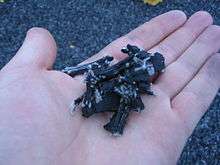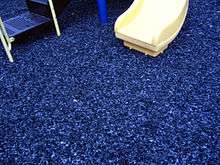Rubber mulch
Rubber mulch is a type of mulch used in gardens and landscaping that is made from recycled rubber.
Composition

Rubber mulch generally consists of either waste tire buffings or nuggets of synthetic rubber from tires that are ground up whole, after having their steel bands removed. Almost any tire can be used to make rubber mulch, including passenger vehicle tires and large truck and trailer tires. Buffings are produced from recycled truck tire tread when the remainder of the worn-down tread is removed from the tire prior to retreading. Buffings are generally thin slivers of rubber. Nuggets range in size from 10 mm to 32 mm, or 3/8 inch to 11⁄4 inch.
Advantages
Rubber mulch provides some advantages over plant mulches. For landscaping and gardening purposes, both nuggets and buffings insulate soil from heat, allowing a 2 or 3 degrees F higher soil temperature difference over wood mulches. Rubber mulch is beneficial for soil moisture, as rubber is non-porous and does not absorb water on its way through to the soil. It also reduces fungus growth and plant growth, and becomes a weed barrier, as weed seeds dehydrate in the mulch before reaching the soil. Neither nuggets nor buffings provide any humus to compacted soil types.

Another advantage over plant-material mulches is its elasticity, which gives it a springy quality when used in a fairly thick layer. This makes it a choice for playgrounds, where the springiness provides additional safety for children when they fall off of playground equipment. Tests have shown that rubber mulch is superior in breaking falls[1] to traditional bark mulches. The International Play Equipment Manufacturers Association has certified some rubber mulches for ASTM F1292-09.[2]
Rubber mulch formally reduces the regional and global carbon footprint by reusing materials that would otherwise end up in landfills. Its durability can be up to twelve times greater than wood mulch, with wood mulch lasting an average of four seasons.
Disadvantages
Unlike organic mulch, rubber mulch does not enrich soil or increase soil biodiversity through decomposition, at worst, it leads to soil contamination (see Environmental Impact and Safety Testing) Some recycled varieties may leach chemicals (some toxic) which are harmful to plants[3][4][5] Rubber mulch is a particular hazard if ignited because of the resulting fumes that resemble those produced in tire fires.
Environmental impact and safety testing
In the US, the Environmental Protection Agency (EPA) has endorsed the use of recycled rubber to cushion the surfaces of children’s playgrounds.[6] In addition, the EPA recently studied air and surface samples at four fields and playgrounds that use recycled tires. The limited study, conducted in August through October 2008, found that the concentrations of materials that made up tire crumb were below levels considered harmful. In addition, the overall study protocol and many of the methods were found to be appropriate and could be implemented in the field.[7] The study, however, did note that due to its limited nature and the large diversity of materials used to make tire crumb, no definitive conclusions could be reached.[7]
The Office of Environmental Health Hazard Assessment of the California Environmental Protection Agency tested skin sensitization by playground surfaces made of recycled tires and found no sensitization observed suggesting that these surfaces would not cause skin sensitization in children, nor would they be expected to elicit skin reaction in children already sensitized to latex.[8]
ChemRisk, Inc. in Pittsburgh conducted a review of exposure to recycled tire rubber found on playgrounds and synthetic turf fields. They concluded that no adverse human health or ecological health effects are likely to result from these beneficial reuses of tire materials.[9]
Although rubber mulch is generally regarded as safe, recycled tire rubber leachates do contain certain minerals and compounds which may be ecotoxic in high concentrations. Recycled tire mulch can contain trace amounts of various minerals from the tire manufacturing process and other chemicals that may have been picked up during the tire's service life. The greater the surface area of synthetic rubber waste pellets, the greater the potential for breakdown into harmful constituents. For leached tire debris, the (potential) environmental impact of the ingredients zinc and organic toxicants has been demonstrated.[10]
See also
- Mulch
- Rubber
- Retreading
- Tire Recycling
- Green Building
- Plastic mulch
- Sustainable landscaping
References
- EPA playground surface
- IPEMA Certification Description Archived 2011-07-13 at the Wayback Machine
- Natures Way Resources
- The Myth of Rubberized Landscapes, Linda Chalker-Scott, Puyallup Research and Extension Center, WSU Archived 2008-09-07 at the Wayback Machine
- Rufus L. Chaney Environmental Chemistry Lab USDA-Agricultural Research Service Archived 2008-05-13 at the Wayback Machine
- EPA endorsement
- EPA fields and playground study
- California EPA playground surface study
- ChemRisk, Inc. study Archived 2010-08-09 at the Wayback Machine
- Gualtieri, Maurizio; Andrioletti, Manuela; Mantecca, Paride; Vismara, Claudio; Camatini, Marina (2005). "Impact of tire debris on in vitro and in vivo systems". Particle and Fibre Toxicology. 2 (1): 1. doi:10.1186/1743-8977-2-1. PMC 1079942. PMID 15813962.
External links
| Wikimedia Commons has media related to Rubber mulch. |